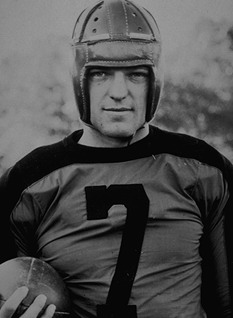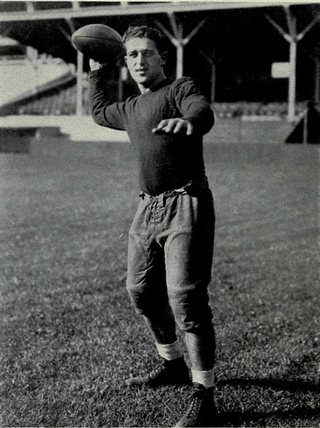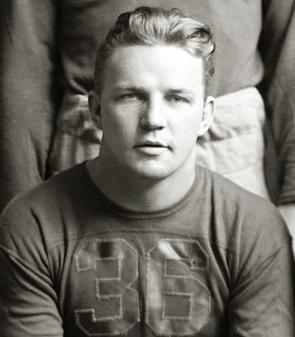Related Research Articles

Clyde Douglas "Bulldog" Turner was an American professional football player and coach in the National Football League (NFL). He was elected, as a player, to the College Football Hall of Fame in 1960 and the Pro Football Hall of Fame in 1966. He was also selected in 1969 to the NFL 1940s All-Decade Team.

Thomas Dudley Harmon, nicknamed "Old 98", was an American football player, military pilot, actor, and sports broadcaster.
The College Football All-America Team is an honor given annually to the best college football players in the United States at their respective positions. The original use of the term All-America seems to have been to the 1889 College Football All-America Team selected by Caspar Whitney and published in This Week's Sports. Football pioneer Walter Camp also began selecting All-America teams in the 1890s and was recognized as the official selector in the early years of the 20th century.

Samuel Blake Chapman was an American two-sport athletic star who played as a center fielder in Major League Baseball, spending nearly his entire career with the Philadelphia Athletics. He batted and threw right-handed, leading the American League in putouts four times. He was previously an All-American college football player at the University of California.

Frank Manning "Bruiser" Kinard Sr. was an American football tackle and coach and university athletic administrator. He was inducted into the College Football Hall of Fame as a charter member in 1951 and into the Pro Football Hall of Fame in 1971.

Earl Harry "Dutch" Clark, sometimes also known as "the Flying Dutchman" and "the Old Master", was an American football player and coach, basketball player and coach, and university athletic director. He gained his greatest acclaim as a football player and was inducted into the College Football Hall of Fame with its inaugural class in 1951 and the Pro Football Hall of Fame with its inaugural class in 1963. He was also named in 1969 to the NFL 1930s All-Decade Team and was the first player to have his jersey retired by the Detroit Lions.

Harry Lawrence Newman was an American professional football player who was a quarterback in the National Football League (NFL) and American Football League. He played college football for the Michigan Wolverines (1930–32), for whom in 1932 he was a unanimous first-team All-American, and the recipient of the Douglas Fairbanks Trophy as Outstanding College Player of the Year, and the Helms Athletic Foundation Player of the Year Award, he was later inducted into the College Football Hall of Fame. He then played professionally for the New York Giants (1933–35), earning All-Pro honors, before joining the Brooklyn/Rochester Tigers (1936–37).

Anthony A. Blazine, Jr. was an American football player and coach. He played college football at Illinois Wesleyan University from 1931 to 1934 and professional football in the National Football League for the Chicago Cardinals and New York Giants from 1935 to 1941. He played at the tackle position. He later served as an assistant football coach at the University of Illinois (1944–1946), University of Nebraska (1947–1948), and Washington State College (1949). He was posthumously inducted into the College Football Hall of Fame in 2002.

Ralph Isaac "Hike" Heikkinen was an All-American guard for the University of Michigan Wolverines football team from 1936 to 1938. He was a unanimous All-American in 1938, the first player from the Gogebic Range area of Michigan's Upper Peninsula to win the honor. His exploits were widely reported in the Upper Peninsula press, where he became a local hero. He played professional football in the National Football League (NFL) with the Brooklyn Dodgers in 1939.
All-Pro is an honor bestowed upon professional American football players that designates the best player at each position during a given season. All-Pro players are typically selected by press organizations, who select an "All-Pro team," a list that consists of at least 22 players, one for each offensive and defensive position, plus various special teams players depending on the press organization that compiles the list. All-Pro lists are exclusively limited to the major leagues, usually only the National Football League; in the past, other leagues recognized as major, such as the American Football League of the 1960s or the All-America Football Conference of the 1940s, have been included in All-Pro lists.

The Utah State Aggies are a college football team that competes in the Mountain West Conference (MWC) of the Football Bowl Subdivision (FBS) of NCAA Division I, representing Utah State University. The Utah State college football program began in 1892 and has played home games at Merlin Olsen Field at Maverik Stadium since 1968. They have won thirteen conference championships in four different conferences during their history, most recently in 2021.

The Washington University Bears football team represents Washington University in St. Louis in college football. The team competes at the NCAA Division III level as an affiliate member of the College Conference of Illinois and Wisconsin (CCIW). They are a primary member of the University Athletic Association, of which they were a founding member. They were previously a founding member of the Missouri Valley Conference whose bigger schools split into the Big Eight Conference and then added a few members to form the Big 12 Conference.
The 1934 College Football All-America team is composed of college football players who were selected as All-Americans by various organizations and writers that chose College Football All-America Teams in 1934. The nine selectors recognized by the NCAA as "official" for the 1934 season are (1) Collier's Weekly, as selected by Grantland Rice, (2) the Associated Press (AP), (3) the United Press (UP), (4) the All-America Board (AAB), (5) the International News Service (INS), (6) Liberty magazine, (7) the Newspaper Enterprise Association (NEA), (8) the North American Newspaper Alliance (NANA), and (9) the Sporting News (SN).
Sheridan High School is a comprehensive four-year public high school located in Sheridan, Arkansas, United States. It is one of two public high schools in Grant County and the sole high school administered by the Sheridan School District.
The 2013 College Football All-America Team includes those players of American college football who have been honored by various selector organizations as the best players at their respective positions. The selector organizations award the "All-America" honor annually following the conclusion of the fall college football season. The original All-America team was the 1889 College Football All-America Team selected by Caspar Whitney and Walter Camp. In 1950, the National Collegiate Athletic Bureau, which is the National Collegiate Athletic Association's (NCAA) service bureau, compiled the first list of All-Americans including first-team selections on teams created for a national audience that received national circulation with the intent of recognizing selections made from viewpoints that were nationwide. Since 1957, College Sports Information Directors of America (CoSIDA) has bestowed Academic All-American recognition on male and female athletes in Divisions I, II, and III of the NCAA as well as National Association of Intercollegiate Athletics athletes, covering all NCAA championship sports.
The 1935 Little All-America college football team is composed of college football players from small colleges and universities who were selected by the Associated Press (AP) as the best players at each position. For 1935, the AP did not select a second team but instead chose multiple players for "honorable mention" at each position.
The 1939 Little All-America college football team is composed of college football players from small colleges and universities who were selected by the Associated Press (AP) as the best players at each position. For 1939, the AP selected both a first team and a second team.
The 1952 Little All-America college football team is composed of college football players from small colleges and universities who were selected by the Associated Press (AP) as the best players at each position. For 1952, the AP followed the precedent established in 1951 by selecting three separate groups: a first team consisting of separate offensive and defensive platoons, and a second team consisting of 11 players.
The 1957 Little All-America college football team is composed of college football players from small colleges and universities who were selected by the Associated Press (AP) as the best players at each position. For 1957, the AP selected three teams of 11 players each, with no separate defensive platoons.
The 1966 Little All-America college football team is composed of college football players from small colleges and universities who were selected by the Associated Press (AP) as the best players at each position. For 1966, the AP selected two teams, each team having separate offensive and defensive platoons.
References
- ↑ "Small School All-American Teams Chosen". The Tacoma Daily Ledger. December 5, 1934. p. 7 – via Newspapers.com.
- ↑ [ bare URL ]